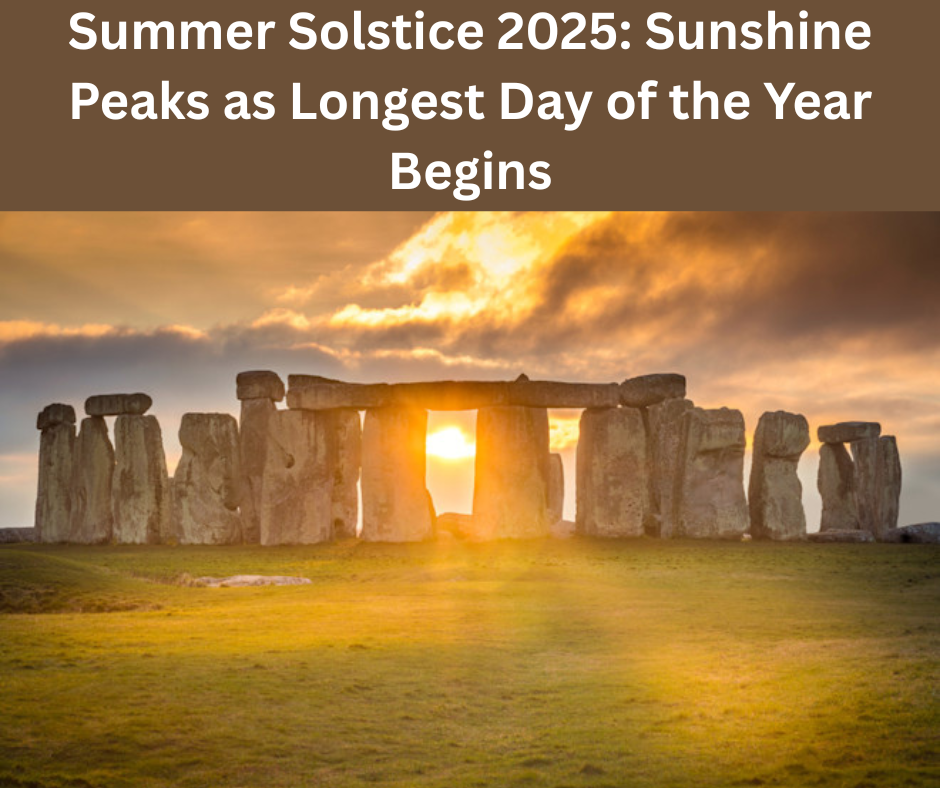Summer Solstice 2025: What It Means, How It Happens, and Why It Matters
As we welcome the Summer Solstice 2025, people across the Northern Hemisphere are preparing for the longest day of the year. Falling on June 20 at 10:42 p.m. EDT, this celestial event marks the beginning of astronomical summer. But beyond just longer daylight and warmer weather, the summer solstice has deep roots in science, culture, and history.
What Is the Summer Solstice 2025?
The Summer Solstice 2025 occurs when the Earth’s North Pole is tilted most directly toward the Sun, causing the Sun to reach its highest point in the sky. On this day, the Northern Hemisphere enjoys its maximum daylight hours, while the Southern Hemisphere experiences the shortest day and longest night.
The word “solstice” originates from the Latin “sol” (sun) and “stitium” (still or stopped), referring to the Sun’s apparent pause in the sky before reversing direction. After the Summer Solstice 2025, daylight hours will gradually shorten each day until the Winter Solstice in December.
Why Does the Summer Solstice Happen?
The phenomenon of the Summer Solstice 2025 is rooted in the tilt of Earth’s axis, which is approximately 23.5 degrees. This tilt is a result of a massive collision with a Mars-sized object (possibly named “Theia”) in Earth’s early history.
Because of this tilt, the Northern Hemisphere leans toward the Sun in June, receiving more direct solar radiation. This results in longer days, shorter nights, and the official start of summer in astronomical terms.
Daylight Extremes During Summer Solstice 2025
During Summer Solstice 2025, daylight duration varies significantly by location:
- In Northern U.S. states, daylight can last between 15 to 16 hours.
- In places near the Arctic Circle, the Sun doesn’t set at all—a phenomenon known as the Midnight Sun.
- In southern regions, like San Juan, Puerto Rico, daylight is closer to 13-14 hours.
At noon on the solstice, the Sun appears highest in the sky for many locations. For example, in Philadelphia, the Sun will reach approximately 73 degrees above the horizon.
Solstices vs. Equinoxes: What’s the Difference?
While the Summer Solstice 2025 is about extremes in daylight, equinoxes occur when day and night are nearly equal in length. The spring (vernal) and fall (autumnal) equinoxes happen when the Earth’s axis is not tilted toward or away from the Sun.
In contrast, solstices (summer and winter) mark the peak of axial tilt, producing either the longest or shortest days of the year.
Astronomical vs. Meteorological Summer
There are two ways to define summer:
- Astronomical summer, which begins with the Summer Solstice 2025.
- Meteorological summer, based on temperature cycles, begins on June 1 and ends on August 31.
The Summer Solstice 2025 marks the celestial start of summer, while meteorologists prefer the calendar-based method to simplify record-keeping.
Historical and Cultural Significance of the Summer Solstice
Throughout history, civilizations have celebrated solstices. Ancient structures like Stonehenge in England and the Pyramids of Egypt align with the Sun’s solstice paths.
- Neolithic cultures likely used the solstice as a seasonal marker for planting and harvesting.
- In Northern Europe, traditions include bonfires, festivals, and all-night celebrations.
- At Stonehenge, thousands gather annually to watch the Sun rise perfectly aligned with ancient stones on the solstice morning.
These customs highlight the importance of the Summer Solstice 2025 as not just an astronomical event, but a deeply cultural one as well.
Sunlight and Twilight During the Solstice
On the Summer Solstice 2025, you might assume the earliest sunrise and latest sunset occur—but they don’t. The earliest sunrise usually happens a few days before (June 14), while the latest sunset comes a few days later (around June 27).
Also, twilight plays a role. Even after the Sun sets, the sky remains lit:
- Around 40° N latitude, twilight lasts just over 2 hours in both morning and evening.
- At 50° N, twilight may persist throughout the night, leaving skies never fully dark.
- In southern regions, twilight ends faster—around 80 to 96 minutes.
Distance from the Sun: A Common Misconception
Many people believe the Earth is closest to the Sun during summer. Actually, it’s farthest away around July 3, a point called aphelion. The perihelion, or closest point, occurs in early January.
Despite being farther from the Sun, the Northern Hemisphere experiences summer because of the angle of sunlight, not the distance. The Summer Solstice 2025 perfectly illustrates this principle.
Conclusion: Celebrating the Summer Solstice 2025
Whether you’re soaking in the sunlight, honoring age-old traditions, or simply appreciating the science behind it, the Summer Solstice 2025 is a moment worth noting. As the longest day of the year, it offers a chance to reflect on our planet’s journey, ancient wisdom, and the wonder of the cosmos.
So, on June 20, step outside, enjoy the extra daylight, and join millions across the globe in recognizing the beauty and significance of the Summer Solstice 2025.
Read more: HDB Financial IPO Valuation

[…] vs India Test Series 2025: Ollie Pope Confirmed as No. 3 Batter for Opening Match Summer Solstice 2025: Sunshine Peaks as Longest Day of the Year Begins HDB Financial IPO Valuation: MD & CEO Reveals Reasons Behind Discounted Pricing Strategy […]
[…] England vs India Test Series 2025: Ollie Pope Confirmed as No. 3 Batter for Opening Match Summer Solstice 2025: Sunshine Peaks as Longest Day of the Year Begins HDB Financial IPO Valuation: MD & CEO Reveals Reasons Behind Discounted Pricing Strategy […]
[…] England vs India Test Series 2025: Ollie Pope Confirmed as No. 3 Batter for Opening Match Summer Solstice 2025: Sunshine Peaks as Longest Day of the Year Begins HDB Financial IPO Valuation: MD & CEO Reveals Reasons Behind Discounted Pricing Strategy […]
[…] England vs India Test Series 2025: Ollie Pope Confirmed as No. 3 Batter for Opening Match Summer Solstice 2025: Sunshine Peaks as Longest Day of the Year Begins HDB Financial IPO Valuation: MD & CEO Reveals Reasons Behind Discounted Pricing Strategy […]